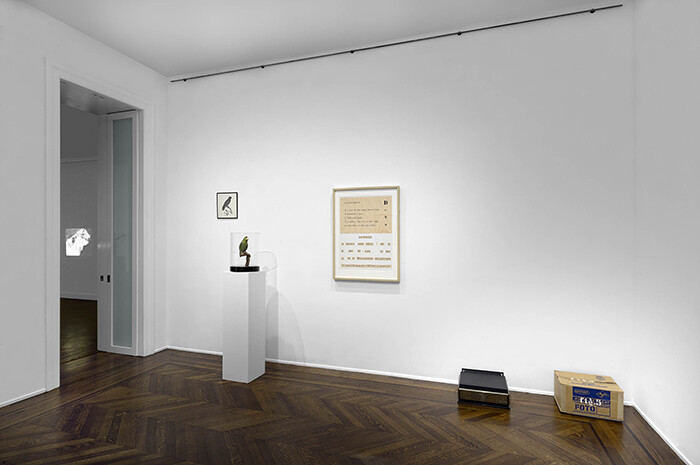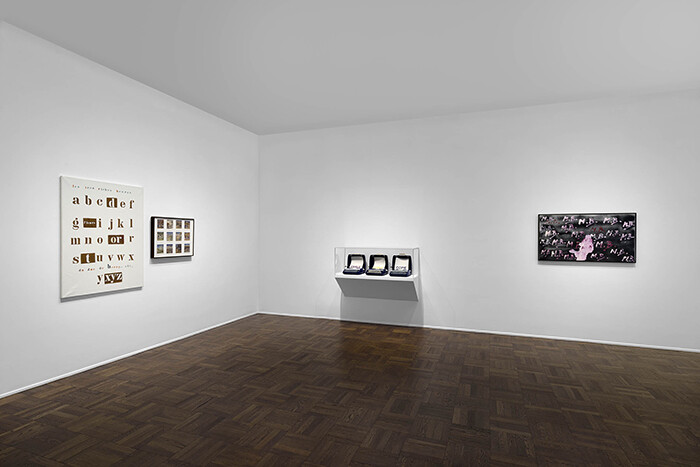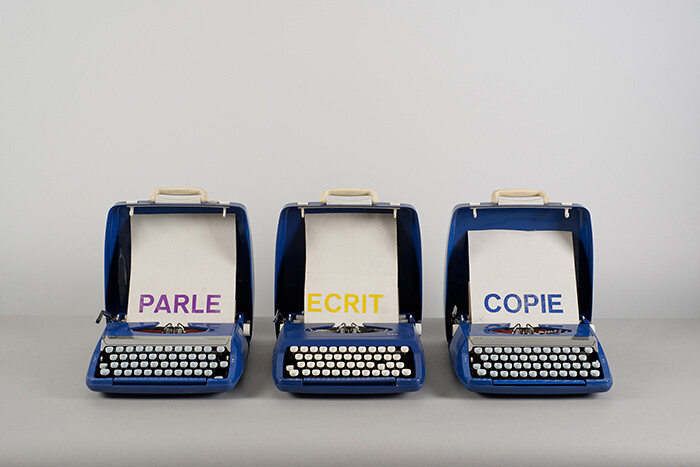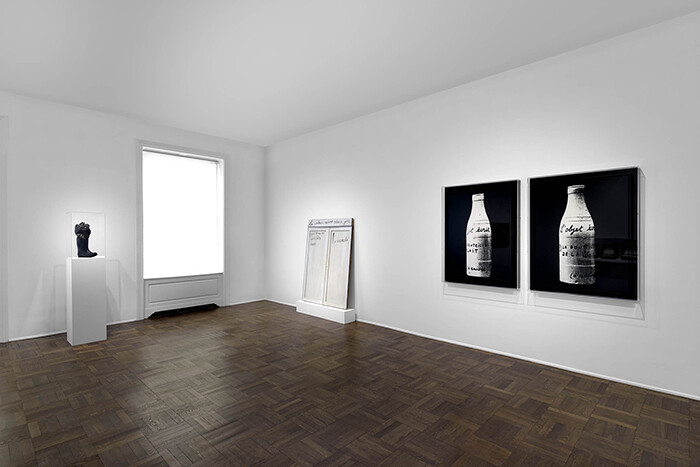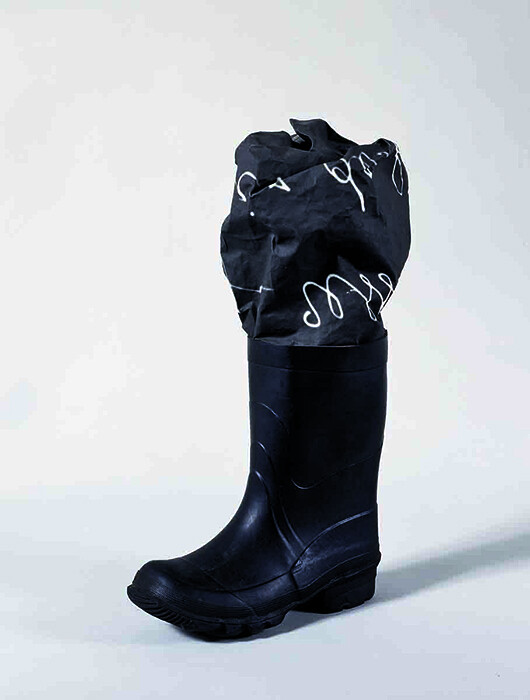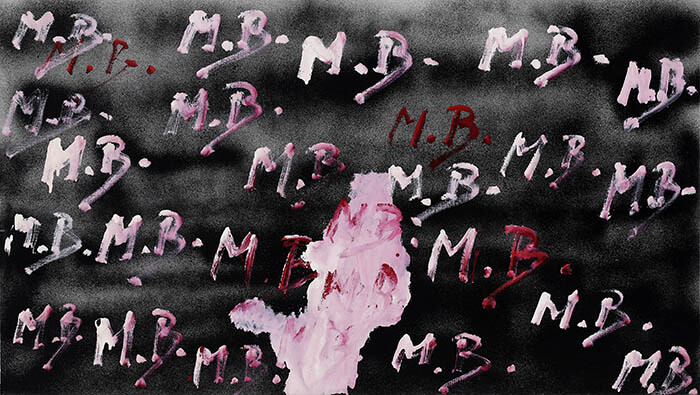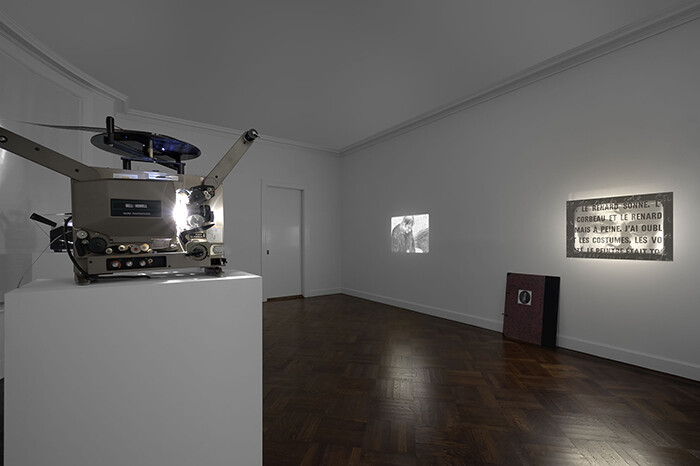It’s only appropriate that visitors to Michael Werner’s current Marcel Broodthaers exhibition would encounter a stuffed parrot as part of the installation Dites Partout Que Je L’Ai Dit (1974). Broodthaers was a master at creatively parroting—both consciously and unconsciously—the tropes, images, and theory that may now seem a bit tame or even passé, but which during his decade or so working as an artist (1963–1976) were some of the most heady and cutting-edge ideas of the time: René Magritte’s indexically challenged “Ceci n’est pas une pipe” as contemplated by Michel Foucault in 1968; Jacques Derrida’s distinction between speech and writing; Jacques Lacan’s string of metonymic associations, etc.
Take, for instance, Parle Ecrit Copie (1972–1973), an image of which could serve quite well as the cover of any of Derrida’s early works. In a wall-mounted vitrine, three nearly identical blue typewriters with raised lids are aligned to face the viewer, with the word PARLE letterpressed in purple on a strip of canvas inserted into the carriage of the one on the left, the word ECRIT letterpressed in yellow for the one in the middle, and COPIE in the typewriters’ same shade of blue placed in the one on the right. Not exactly Derrida’s parole et écriture, but, then, Broodthaers is the opposite of a literalist, and he’s not exactly an appropriationist either. Instead, he looks for the slippage in all forms of language—speech, writing, or copy—and does so with a variety of approaches.
After all, he spent the first half of his creative life as an avant-garde poet, and the linguistic disruptions central to that mode remained with him even after his switch to visual art, at which point he extended them to the indexical. Thus, in Dites Partout Que Je L’Ai Dit the stuffed parrot isn’t matched with the word for parrot, but with a found and framed illustration of a similar bird hung on the wall behind it. After scrambling linguistic references in other works in the show, such as the photographic diptych L’objet écrit (La bouteille de lait) (1967), which gives naming—and language itself—precedence over whatever the bottle originally contained, or the sculpture Boot and photographic canvas (1968), which stuffs handwritten inscriptions on canvas into a black rubber boot so as to render them mostly unreadable, the juxtaposition of a “real” (dead) parrot with its visual equivalent expands Broodthaers’s investigations of representation to perception itself. While it might be subtle, it’s still powerful.
But the best avant-garde poetry (and deconstruction as well, despite being accused of a single-minded focus on the text) does not simply explode language’s meaning-making—or art’s synonymously indexical—function. Rather, it battles with hardened categories. Though not represented in the current exhibition, Broodthaers interrogated images of Belgian nationalism and colonialism by employing imperial eagles and palm trees in his work, as can be seen in the current traveling retrospective of his work.1 (The Belgian Congo was one of Europe’s most brutalized African colonies.) In other words, while it may appear that like a good conceptualist—or deconstructionist—Broodthaers is interested in loosening the relationship between signifier and signified, whether in the realms of the linguistic or the visual, he also aims to disrupt the systems of classification and categorization that restrict and repress far more than they liberate.
At “Marcel Broodthaers: Écriture,” this begins with the signature (more echoes of Derrida, specifically his essay “Signature Event Context” from 1972). Three separate works on display—a pen on paper (Untitled, 1970–1971), a slide projection (Signatures, 1971), and a painting (MB MB MB, 1968)—each undermine the artist’s initials, M. B., through a process of repetition that reveals differences in the same, with the last of these works running the letters “feminine” pink. Broodthaers would want any such categories—beginning with the artist—in quotation; in fact, this is a primary objective of his practice. He consistently tweaked Belgian nationalism by utilizing mussels in his work; and much more than parrots, the aforementioned eagles were his semiotic obsession.
At the same time, I wouldn’t be the first to complain that these formal games can at times feel a bit overly clever, and need lots of explaining, which is why one of my favorite works in the exhibition is a looped short film showing Broodthaers writing with a stylus dipped in ink as water is poured by someone off camera over both him and his words, washing the latter away as he’s inscribing them. Embodied and durational, La pluie (Projet pour un texte) (1969) is less a puzzle to decipher—Broodthaers described his works as rebuses—and more a playfully stoic acceptance of the failures inherent in language. Yet because of the role these failures play in undermining imposed and accepted ways of knowing, they should be celebrated too.
“Marcel Marcel Broodthaers: A Retrospective” is currently on view at Museum of Modern Art, New York, until May 15, and will then travel to Museo Nacional Centro de Arte Reina Sofía, Madrid, in October 2016, and to the Kunstsammlung Nordrhein-Westfalen, Düsseldorf, in early 2017.

